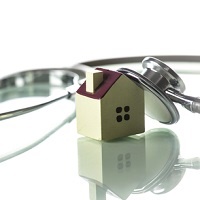
Your building may be affecting your health.
What is sick building syndrome?
"Sick building syndrome" is when people who regularly occupy a building (like office workers) have various troublesome symptoms, mainly when they're in the building. The symptoms tend to be flu- or allergy-like, and may include headaches, burning or itching eyes, a stuffy nose, sneezing, coughing, a sore throat, tight chest, dry or itchy skin, dizziness, difficulty concentrating, nausea and fatigue. It’s hard to link such symptoms to a recognised illness, or identify a specific cause. People prone to asthma or allergies may find that their usual symptoms worsen while in the building.
What causes sick building syndrome?
Sick building syndrome can be the result of poor indoor air quality, caused in turn by inadequate ventilation, faulty or poorly maintained air conditioning systems, and a wide range of indoor chemical pollutants. Indoor air pollution can happen in any building, but is usually specific to modern office blocks, which often have sealed windows (hence, no access to fresh air), and ventilation systems that re-circulate the interior air.
Many building materials and office supplies also emit small amounts of toxins. These include chemically treated wood, plywood and particle board in furniture and fittings; paint; glues; upholstery; curtains; carpets; aerosols; construction materials; cleaning agents; deodorisers and perfumes; photocopy machines, felt-tip pens and correction fluids.
And while work zones now have strict no-smoking laws in place, secondhand smoke is still a culprit. Air contaminated with secondhand smoke can spread if it is not well-contained and ventilation is poor. Secondhand smoke contains hundreds of toxic chemicals that can irritate eyes, nose and throat and cause headaches and nausea.
Air can also become contaminated with biological agents. Mold and bacteria thrive in poorly maintained air conditioning systems or in dirty, damp patches, in bathrooms or around leaky pipes. When organisms grow in ventilation systems, they can spread throughout a building.
Polluted outdoor air may also enter a building and add to indoor pollution. Pollutants from motor vehicle traffic, nearby garages or factories, and from the building’s own exhaust vents, can enter through poorly located air intake vents and other openings. Carbon monoxide gas, a component of car exhaust, is one of the common pollutants that can seep into offices from outside. It can cause fatigue, headache, dizziness and nausea. If inhaled over long time periods, it may affect coordination and worsen heart problems.
Nursing a sick building back to health
Tracking down the source of a building’s malaise may require the services of a health and safety expert. In the meantime, offices can follow simple measures to neutralise the issue:
Ban tobacco smoke
Aim for a completely smoke-free building. Failing that, restrict smoking to a separately ventilated area, as stipulated by the appropriate laws.
Get air flowing
Air circulation in offices can be impeded by partitions. Try raising the base of these further off the floor, or occasionally moving their position. If you work in an older building without air conditioning, keep windows and doors open whenever possible, and use or enquire about installing ceiling fans. Standing fans also help pull in fresh air from outside and keep it circulating.
Get out!
Try to get out of the office on your lunch breaks – preferably somewhere with good natural ventilation. Even a walk round the block should help; if your building is “sick”, chances are the indoor pollution is worse than that outside.
Meet your building manager
Find out who’s responsible for maintenance of the ventilation system – and when it was last checked. All ventilation, heating or cooling systems, including humidifiers, dehumidifiers and air filters, need to be regularly cleaned and adjusted. Report any signs of damp or mold, and if the air feels excessively humid or dry.
Reduce potential indoor air pollution sources
If construction or renovation is planned in a section of your building, motivate to have this part left unoccupied for a few weeks (the longer the better), or at least for it to be thoroughly ventilated. This helps reduce exposure to any chemical pollutants from new building materials. Also ask if cleaning can be done at times of low building occupancy.




 Publications
Publications
 Partners
Partners










